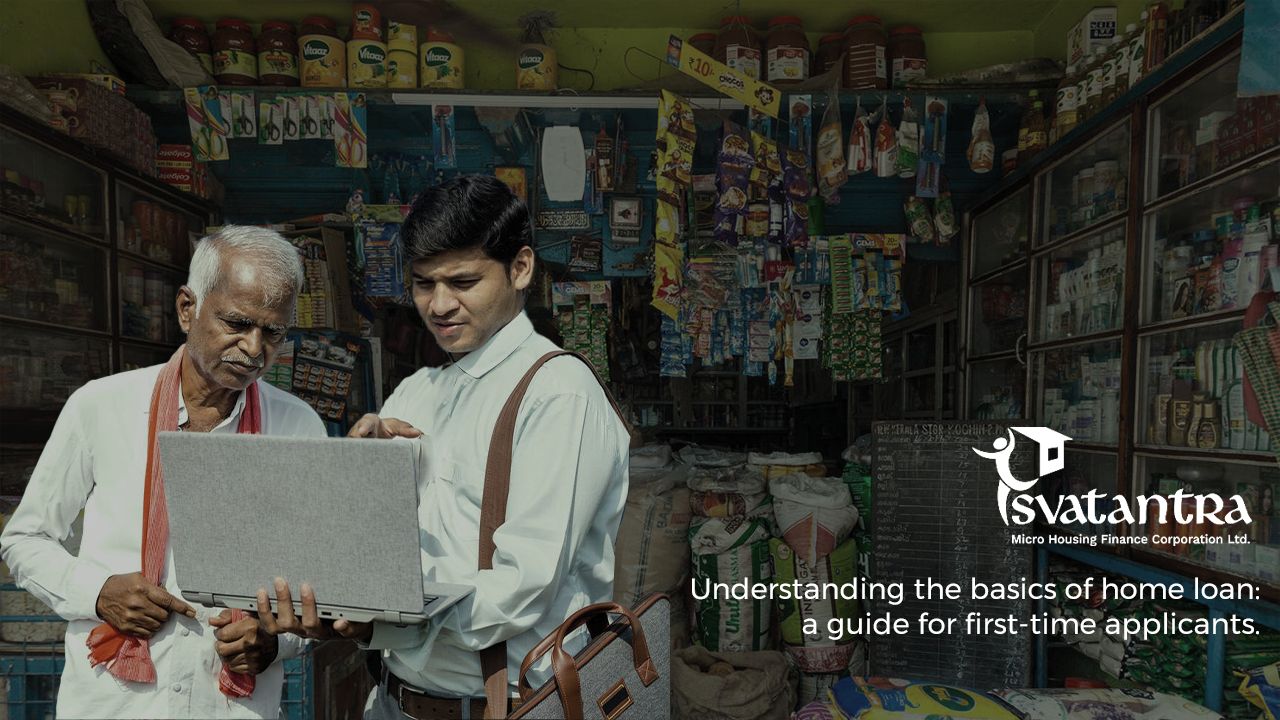LOOKING FOR A NEW HOME LOAN ?
Call Us Today !
 1800 1234 427
1800 1234 427

For many in India, owning a home is a lifelong dream, but the path to homeownership can be challenging. Home loans are designed to make this dream a reality for all individuals and communities, offering financial support to individuals with limited resources. Let's break down the basics of these loans for first-time applicants with Rakesh’s story.
Rakesh owns a small vegetable shop in Jaipur, Rajasthan, and wants to purchase his dream home. He does not have the elaborate documents required to acquire a loan from a traditional bank easily. He also has a limited income. Regardless, his dream of becoming a homeowner is just as important.
Here is a walkthrough of the journey of the LIG and EWS customers like Rakesh:
How does a home loan work?
Home loans are provided by banks or NBFCs to individuals to help them buy their dream homes. There are a few organizations like Svatantra Micro Housing Finance Corporation Limited (SMHFC) that cater to individuals belonging to the LIG and EWS categories, a category that may not have access to conventional banking undertakings.
The first step for customers like Rakesh is to find institutes like SMHFC that can cater to their home loan and service requirements according to their needs, eligibility, resources, and documentation.
Loan Amount: How Much Can You Borrow?
To secure a home loan, the granted amount depends on the applicant's income, the institute’s assessment of the applicant’s repayment capacity, and credit history.
Rakesh’s income is modest yet stable, and he has no history of unpaid debts. This will help his chosen institute to cater to his home loan funding needs. It is important for you to evaluate your budget and income carefully.
Try the SMHFC EMI Calculator: https://svatantramhfc.com/home
Interest Rates: What Will You Pay?
Home loans, especially catering to the LIG and EWS customers, generally offer competitive interest rates, making them affordable for the targeted applicants. The interest rate may vary depending on the institute and loan tenure.
Customers like Rakesh can thus own a home without burning a big hole in their pockets trying to pay off interests.
Loan Tenure and Equated Monthly Installment (EMI): How Long Will It Take to Repay?
EMI is the monthly loan amount you need to repay, consisting of both principal and interest components. SMHFC offers a maximum tenure of 20 years for the customers to pay their EMI. The applicant can then arrive at the EMI suiting their financial situation and what is manageable to them.
While deciding the EMI, the applicant needs to keep in mind tenure and the overall interest costs. Essentially, Rakesh needs to carefully evaluate the budget and repayment capacities to arrive at an EMI that suits his needs.
Documentation: Gathering the Required Papers
To apply for a home loan, you'll need to provide the necessary KYC documents. Such as, at SMHFC, Rakesh would be required to provide Identity Proof, Address Proof, and a bank Statement. However, SMHFC also offers tailor-made solutions, and the final eligibility of a customer is decided upon a number of factors including, but not restricted to income stability, repayment capacity, past credit record, and positive verification
Prepayment: Reducing Your Debt Faster
Like any other loan, home loans also often allow for prepayments, giving applicants the flexibility to reduce their debt ahead of schedule. This can help customers like Rakesh save on interest costs and achieve complete homeownership even sooner. In fact, SMHFC customers like Rakesh will bear no charges on prepayment.
How is Technology Helpful?
Since Rakesh owns a small shop, closing the shop for a day to visit a bank for the loan process will cost him a lot of money. These are precious resources he will need to fulfill his dream of home ownership. This is where doorstep service and technology become extremely helpful. For instance, with SMHFC’s customer-facing app, Rakesh can do everything from applying for a loan to paying his EMIs post-sanction from his mobile phone.
Customers like Rakesh or daily-wage workers thus never have to miss a day’s work or spend money traveling to their own homes.
The Role of Government Schemes
The Pradhan Mantri Awas Yojana (PMAY) scheme, initiated by the Indian government, provides affordable housing solutions to the Economically Weaker Sections (EWS) and Low-Income Groups (LIG) by offering significant subsidies on house loans. This scheme endeavors to make homeownership a reality for many by reducing the financial burden, thereby making homes more affordable. In addition, institutions like SMHFC play a complementary role by providing additional financial services tailored to the needs of customers with limited resources. These institutions offer smaller loans with user-friendly repayment options, thereby broadening the scope of home ownership, and pushing India closer to being a nation of homeowners.
Conclusion
In conclusion, home loans provide a valuable avenue for LIG and EWS applicants to realize their homeownership dreams. With competitive interest rates, tailored solutions, and technology intervention these loans are designed to bridge the gap between aspiration and achievement.
With SMHFC’s doorstep service and our customer-facing app, managing your loan process from application to loan sanctioning and its prepayment becomes easy. If you are eligible and have the ambition to own a home, we suggest exploring SMHFC’s affordable home loans as a viable option to make your dream home come true. Just like some of our existing customers- https://svatantramhfc.com/testimonials
Check out the SMHFC app: http://bit.ly/SMHFCAPP